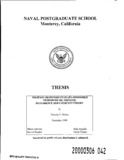Deterrence and the United States Coast Guard: enhancing current practice with performance measures
| dc.contributor.author | Palin, Philip | |
| dc.contributor.author | Hall, Steven | |
| dc.contributor.author | Lewis, Ted | |
| dc.contributor.author | Baldwin, Craig | |
| dc.date.accessioned | 2012-06-04T19:31:59Z | |
| dc.date.available | 2012-06-04T19:31:59Z | |
| dc.date.issued | 2012-03 | |
| dc.identifier.uri | https://hdl.handle.net/10945/7015 | |
| dc.description.abstract | Deterrence displaces or delays unwanted behavior. More ambitiously, deterrence aims to permanently discourage an individual or individuals from such behavior. It operates through the prospect of pain or pleasure. Fear of future pain and hope of future pleasure influence choices, habits, and predilections. Individuals seek to avoid pain and maximize pleasure. Expectations of pain and pleasure will vary, but given an individual’s or group’s specific sensibilities a pattern of pain-minimization and pleasure-maximization persists. An effective deterrence strategy rewards “good behavior” and punishes “bad behavior.” Coast Guard deterrence effectiveness is anchored in a multifaceted approach to safety, stewardship, and security in maritime communities. The Coast Guard is also effective in customizing its approach to particular communities or sub-groups within a community to deter unwanted behavior. However, the Coast Guard has not adopted an explicit data-informed strategy of deterrence. As a result Coast Guard practice and outcomes are uneven, measurement is not possible, and continual improvement is accordingly difficult. The effectiveness of Coast Guard practice is limited by the absence of an organizing theory, systematic process, and measures of performance. Based on the long-time Coast Guard practice of deterrence observed, this study has identified several complementary theories of psychology, sociology, and economics that may be applied to develop a deterrence strategy. Specifically, the theories of Becker, Ostrom, and Kahneman provide a theoretical foundation for a proposed strategy of deterrence and a methodology/tool proposed here called the Deterrence Integration Modeling Environment (DIME). DIME combines these theories with Coast Guard practice and data-informed technology to bridge the gap between theory and operations. Based on these findings, this study recommends the Coast Guard design and build a DIME proof-of-concept system to capture and manage “big data” to advance the new strategy of deterrence. | en_US |
| dc.language.iso | en_US | |
| dc.rights | This publication is a work of the U.S. Government as defined in Title 17, United States Code, Section 101. Copyright protection is not available for this work in the United States. | en_US |
| dc.subject | Deterrence | en_US |
| dc.subject | Deterrent impact | en_US |
| dc.subject | Prospect | en_US |
| dc.subject | Theory | en_US |
| dc.title | Deterrence and the United States Coast Guard: enhancing current practice with performance measures | en_US |
| dc.type | Technical Report | en_US |
| dc.contributor.department | Center for Homeland Defense and Security | |
| dc.identifier.npsreport | UDI# 1181 |
Files in this item
This item appears in the following Collection(s)
-
All Technical Reports Collection
Includes reports from all departments. -
Faculty and Researchers' Publications
-
Other Technical Reports
Technical Reports not otherwise gathered in a named collection





